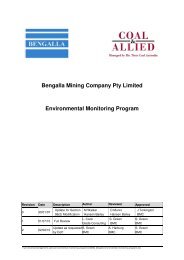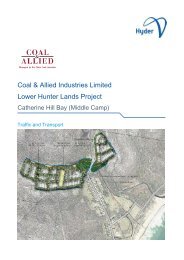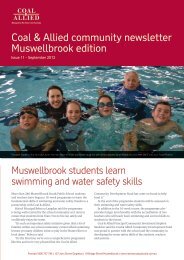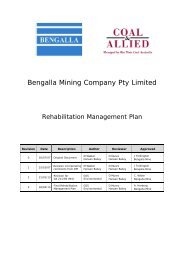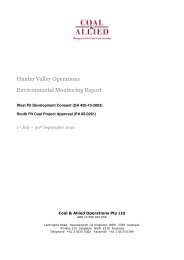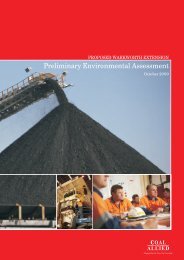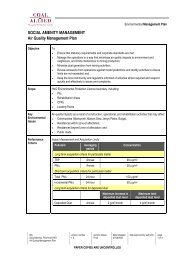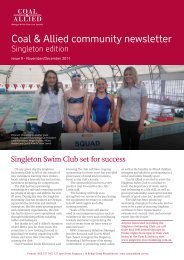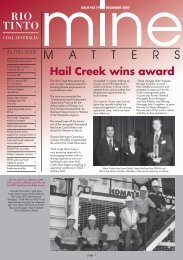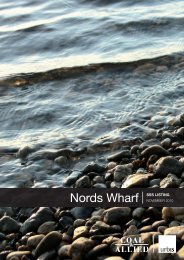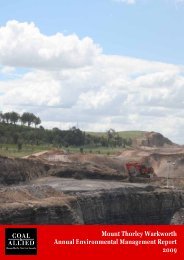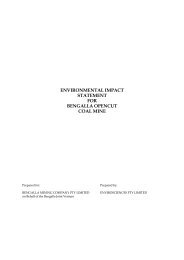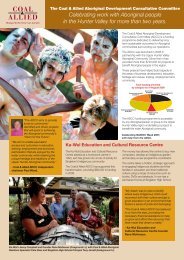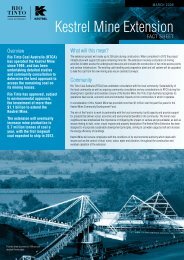HVO 2009 Annual Environmental Management Report - Final
HVO 2009 Annual Environmental Management Report - Final
HVO 2009 Annual Environmental Management Report - Final
You also want an ePaper? Increase the reach of your titles
YUMPU automatically turns print PDFs into web optimized ePapers that Google loves.
Coal & Allied – Hunter Valley Operations<br />
cultural heritage project, cultural heritage investigation and assessment methodologies. They have also<br />
developed a process for the selection and engagement of Aboriginal corporate entities to provide project<br />
management and administrative coordination services and for the selection and engagement of Aboriginal<br />
cultural heritage field officers.<br />
The CHWG developed an innovative process for the selection of administrative coordinators, Aboriginal<br />
cultural heritage field officers, and technical advisors to support the Rio Tinto Coal Australia cultural heritage<br />
program including the conduct the cultural heritage assessment and management work. In consultation with<br />
the CHWG, Rio Tinto Coal Australia advertised nationally for expressions of interest from technical advisors<br />
(e.g. archaeologists, anthropologists, historians) and regionally for both administrative coordinators (e.g. local<br />
Aboriginal corporations) and cultural heritage field officers (e.g. people recognised by the Aboriginal<br />
community as being culturally qualified to conduct heritage work) to register with the CHWG to participate in<br />
project work. Registers of cultural heritage field officers, administrative coordinators and technical advisors<br />
have been established for this purpose. The CHWG oversees the selection and rostering of field officers,<br />
coordinators, and advisors to ensure an equitable and transparent process for the conduct of cultural heritage<br />
field programmes.<br />
The CHWG consultation and cultural heritage management process operates alongside the Coal & Allied<br />
Aboriginal Development Consultative Committee (ADCC) established in 2006. The ADCC has been formed<br />
by Coal & Allied and representatives from the local Aboriginal Community to provide funding for activities and<br />
projects that will benefit the Upper Hunter Aboriginal people. The ADDC aims to develop long term positive<br />
relationships between Coal & Allied and the Upper Hunter Aboriginal community and to build the Aboriginal<br />
community into the future.<br />
3.12.2 <strong>Management</strong> of Archaeology and Cultural Heritage<br />
Archaeology and cultural heritage are managed in consultation with the Aboriginal community in accordance<br />
with the Rio Tinto Cultural Heritage <strong>Management</strong> Standard, Rio Tinto Coal Australia CHMS Work Procedures,<br />
existing Aboriginal Heritage <strong>Management</strong> Plans and Development Consent conditions, the National Parks<br />
and Wildlife Act, 1974 (NPW Act) and the <strong>Environmental</strong> Planning and Assessment Act, 1979 (EP&A Act).<br />
Aboriginal cultural heritage investigations, assessments, surveys and studies (which include archaeological<br />
investigations) are undertaken prior to the commencement of new development activities. Comprehensive<br />
and systematic cultural heritage assessment surveys are conducted by representatives of the Aboriginal<br />
community assisted by technical advisors and Rio Tinto Coal Australia personnel. The Aboriginal community<br />
determine the significance of cultural heritage objects, sites and places and the CHWG meets to discuss<br />
appropriate management measures. Technical advisors provide input for the consideration of archaeological<br />
and scientific significance and associated management requirements.<br />
The Rio Tinto Coal Australia CHMS combines several elements to protect, manage and mitigate cultural<br />
heritage at <strong>HVO</strong> which include;<br />
<br />
<br />
<br />
<br />
Ongoing consultation and involvement of the local Aboriginal community in all matters pertaining to<br />
Aboriginal cultural heritage management;<br />
The Coal & Allied EMS <strong>Environmental</strong> Procedure 2.1 Cultural Heritage <strong>Management</strong>, existing Aboriginal<br />
Heritage <strong>Management</strong> Plans and Development Consent conditions;<br />
A cultural heritage Geographic Information System (GIS) and Cultural Heritage Zone Plan (CHZP)<br />
incorporating cultural heritage spatial and aspatial data (site location, description, assessments, date<br />
recorded, associated reports, management provisions and various other details to assist with the<br />
management of sites);<br />
A GDP system for the assessment and approval of ground disturbing activities to ensure these activities<br />
do not disturb cultural heritage places;<br />
Limit of Disturbance Boundary (LODB) procedures to demarcate approved disturbance areas and<br />
delineate areas not to be disturbed;<br />
Ongoing cultural heritage sites inspections, monitoring and auditing along with regular compliance<br />
inspections of development works;<br />
AEMR <strong>2009</strong> 139



